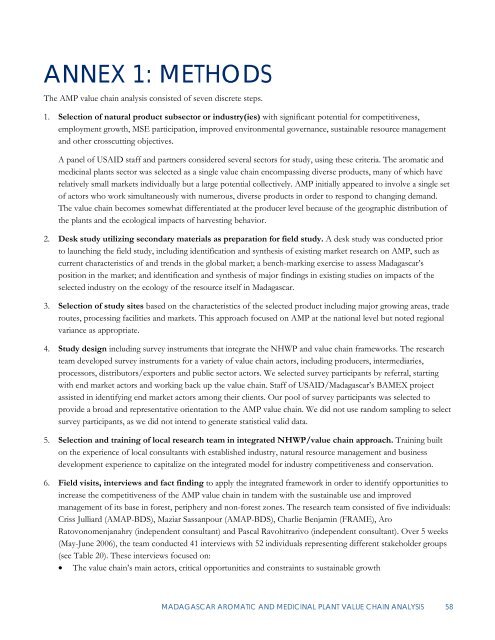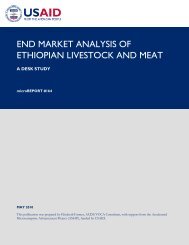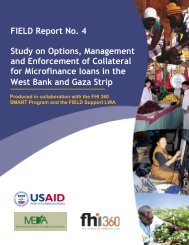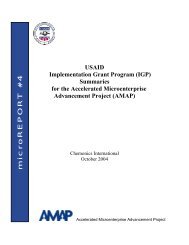Madagascar Aromatic and Medicinal Plants Value - Microlinks
Madagascar Aromatic and Medicinal Plants Value - Microlinks
Madagascar Aromatic and Medicinal Plants Value - Microlinks
Create successful ePaper yourself
Turn your PDF publications into a flip-book with our unique Google optimized e-Paper software.
ANNEX 1: METHODS<br />
The AMP value chain analysis consisted of seven discrete steps.<br />
1. Selection of natural product subsector or industry(ies) with significant potential for competitiveness,<br />
employment growth, MSE participation, improved environmental governance, sustainable resource management<br />
<strong>and</strong> other crosscutting objectives.<br />
A panel of USAID staff <strong>and</strong> partners considered several sectors for study, using these criteria. The aromatic <strong>and</strong><br />
medicinal plants sector was selected as a single value chain encompassing diverse products, many of which have<br />
relatively small markets individually but a large potential collectively. AMP initially appeared to involve a single set<br />
of actors who work simultaneously with numerous, diverse products in order to respond to changing dem<strong>and</strong>.<br />
The value chain becomes somewhat differentiated at the producer level because of the geographic distribution of<br />
the plants <strong>and</strong> the ecological impacts of harvesting behavior.<br />
2. Desk study utilizing secondary materials as preparation for field study. A desk study was conducted prior<br />
to launching the field study, including identification <strong>and</strong> synthesis of existing market research on AMP, such as<br />
current characteristics of <strong>and</strong> trends in the global market; a bench-marking exercise to assess <strong>Madagascar</strong>’s<br />
position in the market; <strong>and</strong> identification <strong>and</strong> synthesis of major findings in existing studies on impacts of the<br />
selected industry on the ecology of the resource itself in <strong>Madagascar</strong>.<br />
3. Selection of study sites based on the characteristics of the selected product including major growing areas, trade<br />
routes, processing facilities <strong>and</strong> markets. This approach focused on AMP at the national level but noted regional<br />
variance as appropriate.<br />
4. Study design including survey instruments that integrate the NHWP <strong>and</strong> value chain frameworks. The research<br />
team developed survey instruments for a variety of value chain actors, including producers, intermediaries,<br />
processors, distributors/exporters <strong>and</strong> public sector actors. We selected survey participants by referral, starting<br />
with end market actors <strong>and</strong> working back up the value chain. Staff of USAID/<strong>Madagascar</strong>’s BAMEX project<br />
assisted in identifying end market actors among their clients. Our pool of survey participants was selected to<br />
provide a broad <strong>and</strong> representative orientation to the AMP value chain. We did not use r<strong>and</strong>om sampling to select<br />
survey participants, as we did not intend to generate statistical valid data.<br />
5. Selection <strong>and</strong> training of local research team in integrated NHWP/value chain approach. Training built<br />
on the experience of local consultants with established industry, natural resource management <strong>and</strong> business<br />
development experience to capitalize on the integrated model for industry competitiveness <strong>and</strong> conservation.<br />
6. Field visits, interviews <strong>and</strong> fact finding to apply the integrated framework in order to identify opportunities to<br />
increase the competitiveness of the AMP value chain in t<strong>and</strong>em with the sustainable use <strong>and</strong> improved<br />
management of its base in forest, periphery <strong>and</strong> non-forest zones. The research team consisted of five individuals:<br />
Criss Julliard (AMAP-BDS), Maziar Sassanpour (AMAP-BDS), Charlie Benjamin (FRAME), Aro<br />
Ratovonomenjanahry (independent consultant) <strong>and</strong> Pascal Ravohitrarivo (independent consultant). Over 5 weeks<br />
(May-June 2006), the team conducted 41 interviews with 52 individuals representing different stakeholder groups<br />
(see Table 20). These interviews focused on:<br />
• The value chain’s main actors, critical opportunities <strong>and</strong> constraints to sustainable growth<br />
MADAGASCAR AROMATIC AND MEDICINAL PLANT VALUE CHAIN ANALYSIS 58





